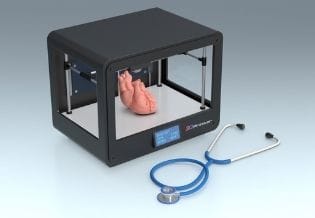Author Contributions
Academic Editor: Alessandra Caggiano, University of Naples Federico II
Checked for plagiarism: Yes
Review by: Single-blind
Copyright © 2018 Amir Dehghanghadikolaei
 This is an open-access article distributed under the terms of the Creative Commons Attribution License, which permits unrestricted use, distribution, and reproduction in any medium, provided the original author and source are credited.
This is an open-access article distributed under the terms of the Creative Commons Attribution License, which permits unrestricted use, distribution, and reproduction in any medium, provided the original author and source are credited.
Competing interests
The authors have declared that no competing interests exist.
Citation:
Introduction
Additive Manufacturing (AM) is the most recent method to fabricate 3D components. The general idea of this process is to use 3D CAD files, slice the file into desired values depending on accuracy, and send them to a computer processing unit 1. Several AM techniques are used for fabricating metallic alloys that powder-based methods are the most common ones. Selective laser sintering (SLS), self-propagation high temperature synthesis (SHS), selective laser melting (SLM), direct metal sintering (DMLS) and electron beam melting (EMB) are the most common ones. Other uncommon additive manufacturing techniques are laser engineered net shaping (LENS), direct light fabrication (DLF), laser consolidation, laser cladding and shape deposition manufacturing (SDM) which are flow-based. Most of these processes are executed under controlled atmosphere or with support of inert gases to purge the chamber and keep oxygen level below a standard value. One of the most important applications of AM processes could be named as fabricating patient specified implants from tough alloys that cause difficulties during conventional fabrication methods 2. One of these materials is an alloy of nickel and titanium, known as NiTi, which offers excellent biocompatibility properties and shape memory and superelastic behaviors. Using AM techniques offers significantly easier fabricating procedure for this specific alloy 3. However, similar to any other new techniques, AM has to undergo numerous investigations regarding its effects on change of mechanical properties, corrosion behavior and overall performance. From other perspective, the effect of post treatment processes such as heat treatment, coating, machining and finishing should be investigated as the parts are fabricated in a layer-by-layer fabricated process 4, 5. In the next step, one has to compare the change of all the mentioned parameters and reveal the effect of fabrication process.
To date, many AM processes are being investigated on fabricating 3D parts out of different materials such as plastics, polymers, metals, and ceramics. Thus, there is always an opportunity to have a scientific look at defects of each of these studies and find a solution. “Journal of 3D printing and applications” encourages the submission of papers focusing on AM of engineering materials, post processing of AM parts and investigation of new possibilities in this field. All forms of papers are welcomed, including review, original research article, perspective, short communications, etc.
References
- 1.Elahinia M.et al.,Additive manufacturing ofNiTiHfhigh temperature shape memory alloy.Scripta. Materialia,2018. 145:p. 90 - 94.
- 2.N S Moghaddam.et al.,Anisotropic tensile and actuation properties ofNiTifabricated with selective. laser melting.Materials Science and Engineering: A,2018.724: 220-230.
- 3.M H Elahinia.et al.,Manufacturing and processing ofNiTiimplants: A review.Progress in materials science,2012.57(5):. 911-946.
Cited by (1)
- 1.Buresh Donald L., Segreto Tiziana, 2019, 3D Printing and Section 512(c): Safe Harbor Provision of the Digital Millennium Copyright Act, Journal of 3D Printing and Applications, 1(1), 5, 10.14302/issn.2831-8846.j3dpa-19-2603
